syn_ @ Southbank
Having variously stared at the floor and attempted to disappear behind his own hand during the event organisers’ laudatory introductions of him, Ryoichi Kurokawa takes the stage quickly and silently. BFI Southbank’s NFT1 is sold to capacity1 and in near complete darkness, the brightest light source in the room being the glowing apple on the lid of one of Kurokawa’s MacBooks. This is the debut UK performance of syn_ (2011), a powerful and complex sensory experience which is at times designedly overwhelming. The piece is an evolution of cm: av_c (2005), a version of which was presented at Tate Modern in 2007, and the performance is Kurokawa’s first in the UK since appearing at The Roundhouse in 2010.
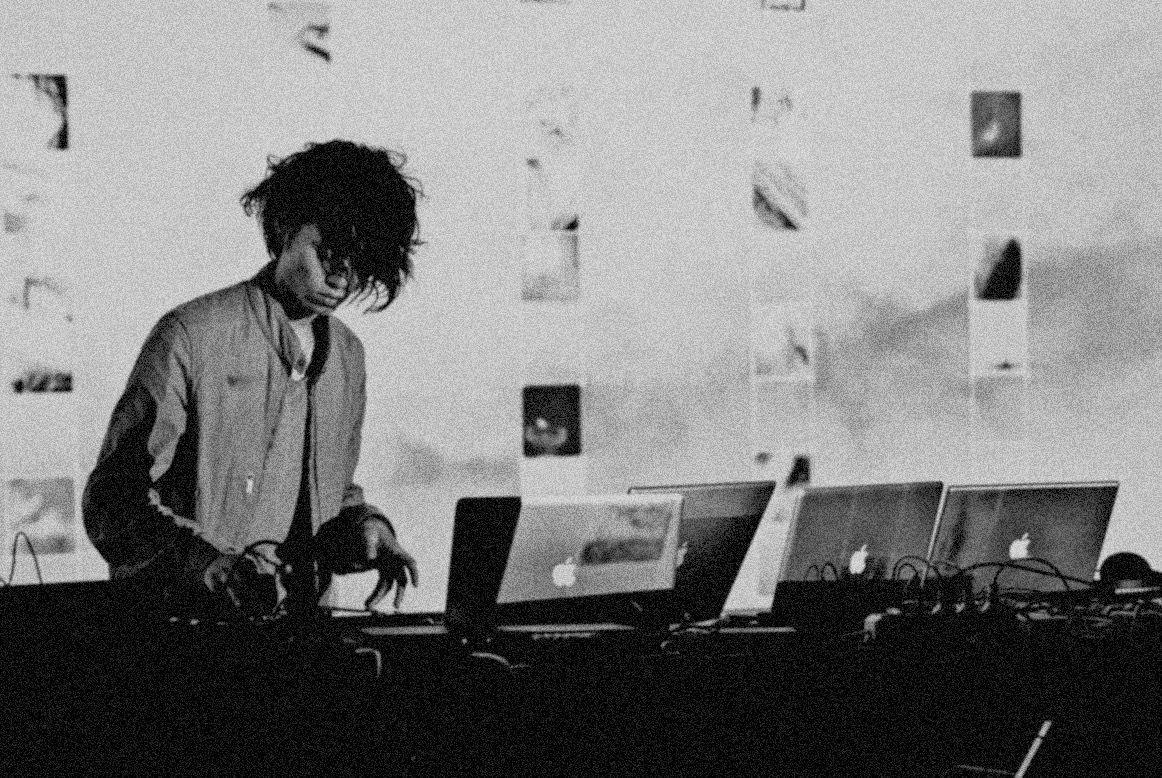 Photo by Simona Silvestri
Photo by Simona Silvestri
Just about discernible, silhouetted against a pair of giant projected screens, Kurokawa works concentratedly and fluidly at a pair of laptops, mixing and affecting image and sound which comes now in a stream, now in a barrage, and then in fits and starts. Skittering, incomplete breakbeats loop in and out of beds of white and pink noise; bass or synth throbs, crescendos, dies; the seeming randomness of this least-hummable of music actively combats the tendency of ear and mind to relax into the familiarity of pattern recognition.
It goes similarly with the visuals: they flare up, flash, morph one to another to another, spawn unanticipated lines of connection. Whilst the event notes entreat the viewer/listener not to ‘digest gradually with the head’ but rather to ‘feel simultaneously with the eyes and ears’, I found myself able to experience the work at this pre-cognitive level only for very short periods. The mind’s tendency toward processing and categorisation is too strong and too deeply ingrained to consistently suppress, and even making the effort to do so with respect to higher cognition, I found myself incapable of not perceiving the visual elements of the piece as belonging to particular sets: organic, geometric, topographical….
As brilliantly matched as the aural and visual elements of syn_ are, the differences between the acts of listening and looking become starkly apparent. I was aware of sonic elements shifting between the left and right speakers, but never felt that I was hearing only part of the composition. Conversely, the separation of the visuals over two screens—combined with my relative closeness to the stage—meant that it was only possible to take in the visuals from one or other at any one time. The volume and frequencies of the music are balanced to be loud but not challenging, whereas the visuals are occasionally tuned to be difficult to watch: too bright and too sudden, bracketed by periods of darkness.
As both live music and a visual arts experience, the 45-minute performance was quite unlike anything I’ve witnessed before. Enthralling and powerful, it makes a compelling case for the digital arts as live event.2
With thanks to Creative Applications and Alpha-ville for supplying the tickets.↩︎
See also Kurokawa’s latest work: an audiovisual sculpture titled oscillating continuum (2013).↩︎
Liminal Squared @ White Cube
My memory of Tate Modern’s Rothko exhibition in 2011 is of sitting, stunned, in front of these huge canvases that to me up until that point had only been images in books or on screens. It was the kind of visceral encounter with visual art that happens all too rarely—a qualitatively different experience to the usual ocular/intellectual engagement that comes from wandering a gallery.
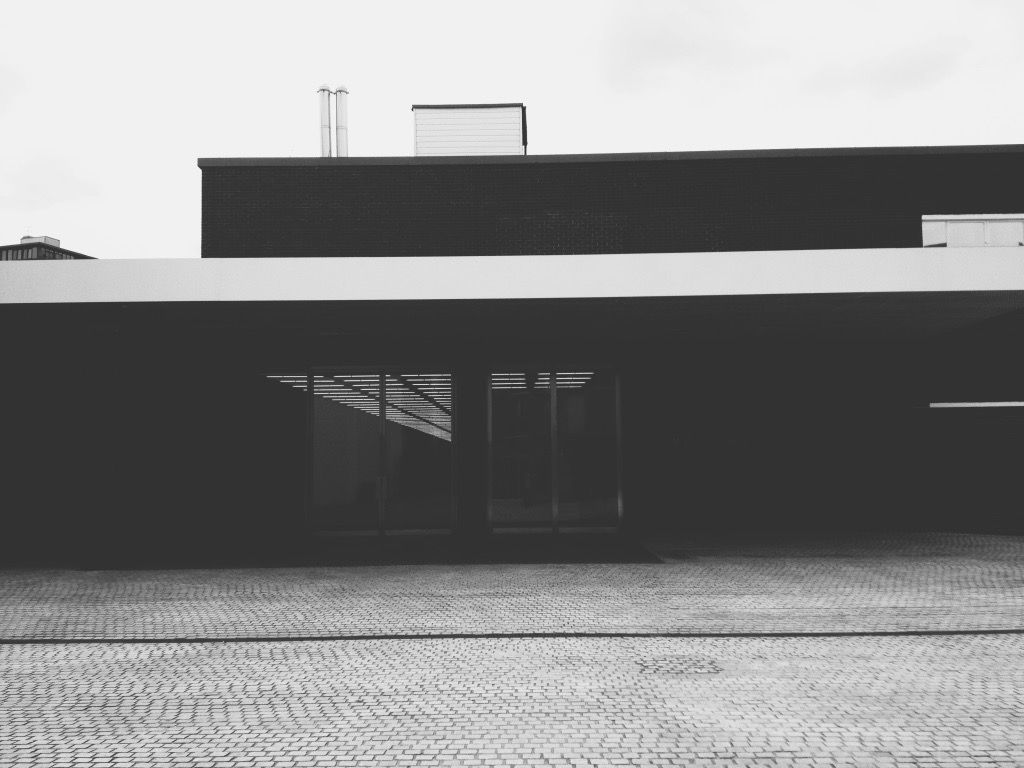
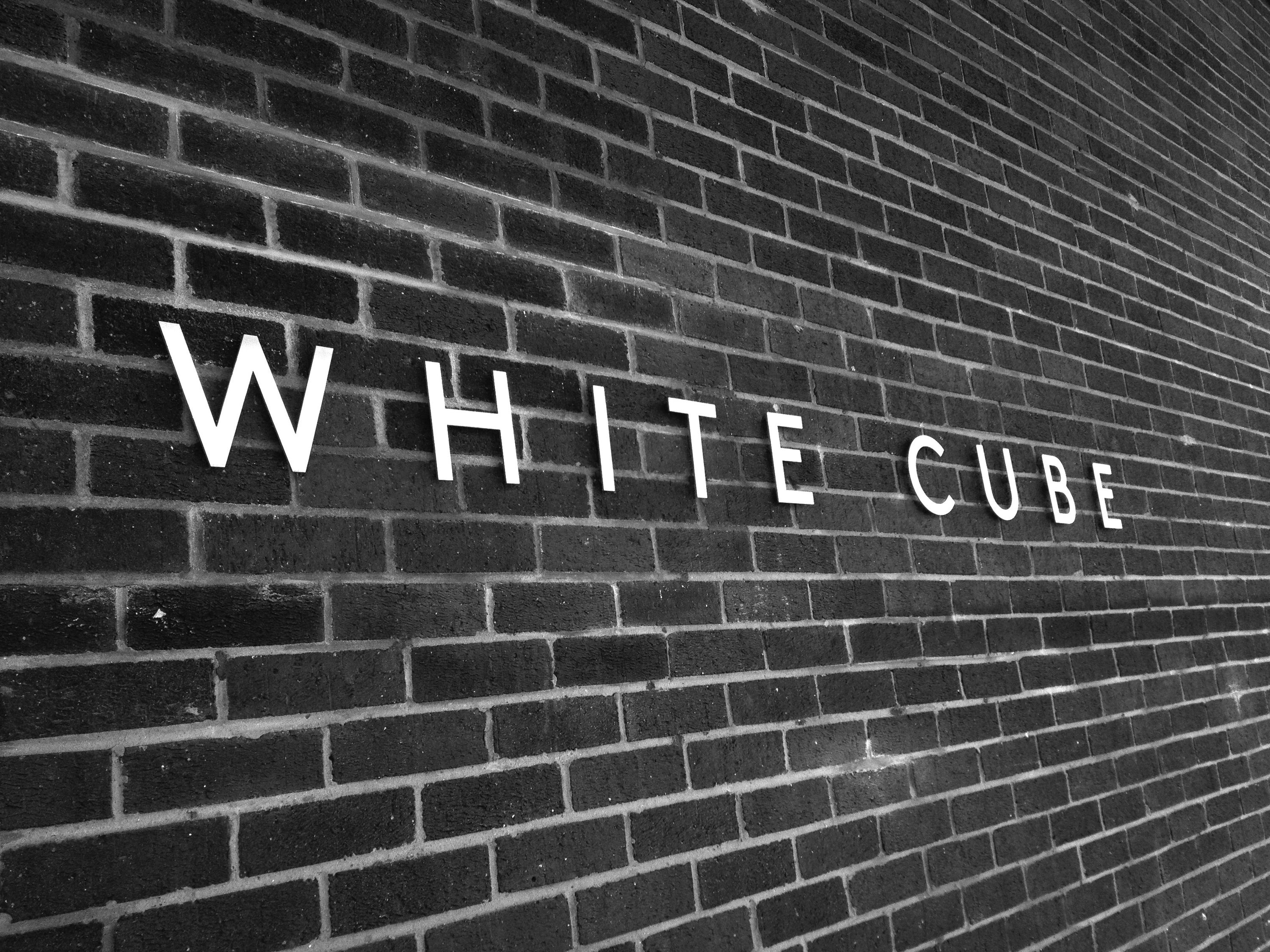
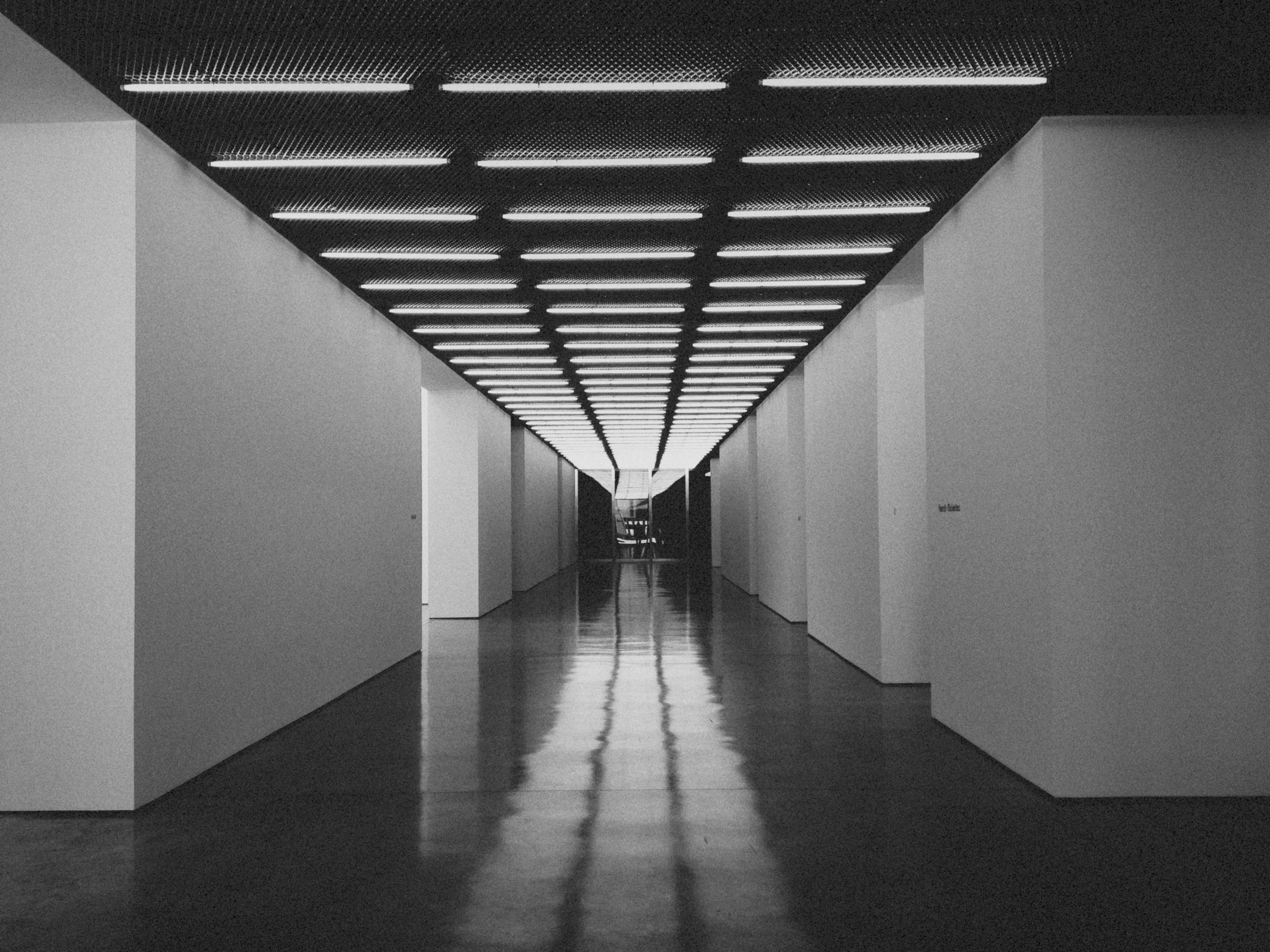
Something similar happened when I recently paid my first visit to White Cube, a gallery on Bermondsey Street in South East London. I had read about an exhibition—titled Liminal Squared—by Ethiopia-born artist Julie Mehretu, which represented her reaction to the recent and ongoing protests, demonstrations, and revolutions throughout north Africa and western Asia.
Totalling twelve pieces over three separate galleries, I was repeatedly surprised by the scale in which Mehretu worked. The first piece that you encounter as you enter South Gallery I is Kabul (2013). It’s a large room, featureless as the venue’s name suggests, and the 243.8 x 365.8cm canvas, along with the even larger Invisible Sun (algorithm 2) (2013) on the adjoining wall, dominate the white surfaces. I sat on the gallery floor to read the artist’s bio, and looking up at these pieces made them feel all the more imposing. As you continue to look at them, new elements surface: exacting, digitally-drawn, blueprint-style lines; pencil elements drawn with a ruler (less exacting but still so); smudges of carbon or paint; bold lines of acrylic colour; loops and strikes of black in varying degrees of boldness. Up close, elements appear layered, some visible as though seen through tracing paper.
On the train that morning I had started reading Adam Thirlwell’s novella Kapow! (2012), which is also a kind of response to the same geo-political events. Mehretu’s work brought to mind a passage in which the narrator begins to think about complexity and connectedness:
in my suspended state I was developing a theory that the important thing was to make connections between as many disparate objects as possible, like Godard saying somewhere that an image shouldn’t be a comparison so much as a meeting of two more or less separated realities. The more the relations between the two realities are distant and just, said JLG, the more the image will be a strong one.1
The second gallery—9x9x9—has a set of five smaller etchings and another huge piece: Aether (Venice) (2011) (456.5 x 345.5cm).
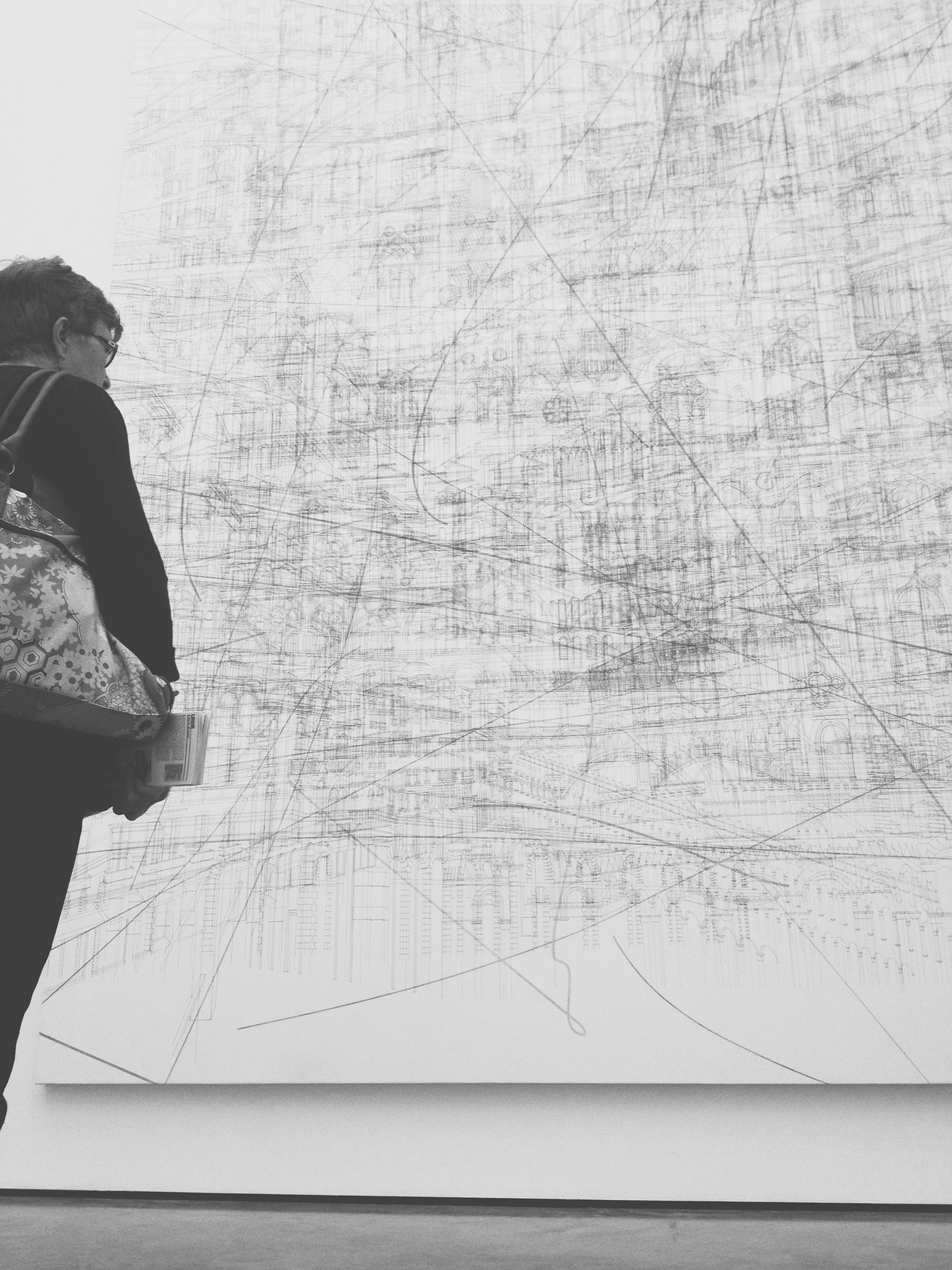
Pre-dating Kabul by two years, Aether (Venice) shares much of its techniques as well as its scale. The decision to display it after the more recent work is likely down to keeping the five 2013 pieces together in the first gallery. Similarly, the works collected in the third and final space—South Gallery II—belong together, as they comprise a series: Mogamma: A Painting in Four Parts (2013). The way these pieces are displayed at White Cube is stunning: the four 457.2 x 365.8cm canvases angled into a central seating area, the white walls on which they are hung enveloped by deep pockets of shadow that delineate this quartet whilst also creating a unique, private-feeling space in which to experience it.
Liminal Squared is at White Cube, Bermondsey until 7 July 2013. New York’s Marian Goodman Gallery also showed new work by Mehretu, concurrent with the White Cube exhibition. A joint catalogue is due to be published in July.
Thirlwell, Adam. Kapow!. London: Visual Editions, 2012. 10-11↩︎
Exposed @ Tate Modern
Looking down from Tate Modern’s first floor balcony you can see the scar left by Doris Salcedo’s 2007 exhibit Shibboleth, a lightning strike of new concrete that runs the length of the vast Turbine Hall. Perched up here you could happily spend a great deal of time watching people coming in from the rain and negotiating the hall’s gentle slope. Though currently empty, the room still has the power to elicit a response. Children run and skip when they get through the doors, people are sat against walls eating their lunch, and here and there bodies are sprawled on the floor as people stare up at the steel-girder ceiling. This is part of what Tate Modern has brought to London in the ten years since it opened: an inviting public space in which to encounter visual art, and the idea that art-appreciation shouldn’t be solely the province of small, intimidating, elitist galleries. As one of five million visitors per year you are afforded both the chance to view some spectacular modern art, and the chance to observe other people doing the same.
The latest exhibition to take up residence on Tate Modern’s fourth floor, Exposed: Voyeurism, Surveillance & the Camera, combines these ideas of art and people-watching, and challenges us to reconsider where the boundaries might lie. Over five thematic sections through more than a dozen rooms the visitor is presented with images that raise questions of intent, privacy, security and eroticism.
Entering the first room of the exhibition you’re met with enlargements of shots from Philip-Lorca diCorcia’s series Heads. The images were taken from a great distance when pedestrians in New York unwittingly tripped automatic lights diCorcia had rigged on the sidewalk. The text accompanying the photos tells you that one of the artist’s subjects took legal action against him, with the court eventually ruling in diCorcia’s favour. By choosing to present this material first it feels like the exhibition’s curators are tipping their hand in the voyeurism vs art debate that plays out over the following rooms. In the rest of the ‘Unseen Photographer’ section we’re shown images taken through buttonhole cameras (neatly presented in circular frames) and one-way mirrors, and introduced to the technology of the ‘lateral viewfinder’, positioned at a right angle to the camera’s true lens to allow for surreptitious ‘sideways’ photography.
The sequencing of ‘Celebrity & the Public Gaze’ as the next section asks the visitor to consider whether the rules are—or should be—different for the famous. The curators have performed a careful balancing act, leaving the question open for the viewer. There are several of Ron Galella’s photos of Jackie Kennedy, one (‘What makes Jackie Run’) in which she is actively fleeing the photographer. On an adjoining wall Marilyn Monroe’s dress billows as she poses atop an air vent. The fact of the subjects’ celebrity brings a unique push and pull to the relationship between photographer and photographed, and challenges us to separate public and private personae. The vibrant candid shot of Jack Nicholson that dominates one wall shows him swinging a golf club at the car of a driver who had just cut him up. There is a strange ‘in-character’ element to the image, and it takes effort to see it as something other than a movie screenshot.
The next two sections are the exhibition’s most challenging, and form a duologue of two big themes: sex & death. It’s not so much the explicit nature of the images within ‘Voyeurism & Desire’ that sets you on edge, as much as the element of illicitness in their having been taken, and now in their being displayed. I felt acutely aware of the people around me through these rooms, and watching others’ efforts to appear to be appreciating this art in an acceptable manner added an enjoyable meta-level to the exhibition’s central themes. This section also contained some of the most striking images, and two exceptional pieces of hanging: selections from Merry Alpern’s Dirty Windows series presented in four rows and three columns evoking a grid of windows in a tower block; and the frankly creepy shots from Kohei Yoshiyuki’s 1971 infrared series The Park individually illuminated by spotlights in a darkened corridor.
‘Witnessing Violence’ develops another human preoccupation in similarly captivating fashion. In amongst the obligatory stills from the Zapruder film, Oliver Lutz has found a way to place the observer within the image. A large black canvas hangs alone on one wall, its image only revealed when the viewer looks at a monitor positioned nearby so as to frame them directly in front of the picture. The technique, which involves covering the photograph in infrared sensitive pigment, is perhaps a little gimmicky, but nevertheless impactful as another way of making the visitor reassess their relationship with the images on display.
The final section, ‘Surveillance’, is perhaps the weakest. The divide between viewer and subject is increased, the images are often of lesser resolution and there is a detectable lack of human engagement in their making. These are largely pictures taken automatically, or single frames from an automated recording; simply in terms of composition, colouration and focus you can tell that there is not a human interest overseeing their manufacture. As a result I felt detachment from these last photographs where the majority of what had preceded had engaged me.
Throughout the exhibition I sensed a lack of interest in narrative. The images on display were taken quickly or secretly or both, with the aim being to capture a single, true moment. The act of doing this removes that moment from its context and allows the viewer to wrap their own story around it. Every invasion of privacy with which we are confronted is simultaneously an invasion of our privacy and our invasion of someone else’s. Each image of violence invites us to imagine ourselves as victim, perpetrator and onlooker. In some cases, where a set of photos from the same series is presented, a story does begin to take shape—such as that in Enrique Metrinides’ ‘Suicide Rescue from the Top of the Toreo Stadium’—but even in these instances the narrative is abstract and incomplete. In this sense the exhibition demands every bit as much work on the part of the viewer as some of the abstract and impressionist work in the Tate’s permanent collection. For those interested in how the camera has changed our relationship to the world and each other, it is just as richly rewarding.